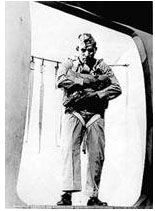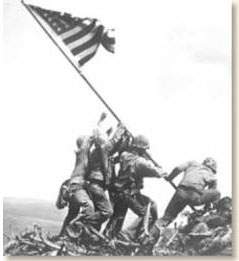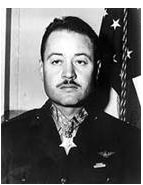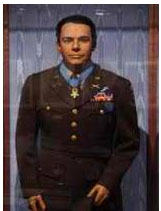During World War Two as time approached for Churchill, Roosevelt, and Stalin to meet in person coordinate the promised allied effort; Joseph Stalin refused to leave Moscow; Teheran, the capital of Iran, was finally chosen as the meeting place—discussions ran from November 28 to December 1, 1943
Agreement was reached on a broad plan for launching Soviet attacks on Germany from the east simultaneously with the prospective Allied assault from the west (cross-channel invasion of France)
Britain prepared nearly 3 million fighting men but the US provided most of the Allied warriors
The war prompted an exodus of Native Americans from the reservations; thousands found war work in the major cities; some 25,000 Native American men served in the armed forces
Comanche and Choctaws in Europe and Navajos in the Pacific made especially valuable contributions as “code talkers”—they transmitted radio messages in their native languages (incomprehensible to the enemy).
Native American Warriors from all over this Indian country served in this combat. One was part of the most revered icon of the US Marine Corps: the Iwo Jima flag rising. Three distinguished themselves in World War Two combat and received the Nations’ highest award, the Congressional Medal of Honor.
Ira Hayes, Oodham
Ira Hamilton Hayes, USMC Airborne Warrior was a participant in the famous WW II flag raising, February 25, 1945, on Mount Suribachi Iwo Jima. He was a Akimel Oodham, Pima, born at Sacaton, Arizona, on 12 January 1923. In 1932, the family moved a few miles southward to Bapchule. Both Sacaton and Bapchule are located within the boundaries of the Gila River Indian Reservation in south central Arizona. Hayes left high school after completing two years of study. He served in the Civilian Conservation Corps in May and June of 1942, and went to work as a carpenter.
 On
26 August 1942, Ira Hayes enlisted in the Marine Corps Reserve at Phoenix,
Arizona for the duration of the National Emergency. Following boot camp
at the Marine Corps Recruit Depot at San Diego, Hayes was assigned to
the Parachute Training School at Camp Gillespie, Marine Corps Base, San
Diego. Ira Hayes graduated one month later, the Akimel Oodham Marine Warrior
was qualified as a parachutist on 30 November and promoted to Private
First Class the next day. On 2 December, he joined Company B, 3d Parachute
Battalion, Divisional Special Troops, 3d Marine Division, at Camp Elliott,
California, Then he sailed for Noumea, New Caledonia, on 14 March 1943.
On
26 August 1942, Ira Hayes enlisted in the Marine Corps Reserve at Phoenix,
Arizona for the duration of the National Emergency. Following boot camp
at the Marine Corps Recruit Depot at San Diego, Hayes was assigned to
the Parachute Training School at Camp Gillespie, Marine Corps Base, San
Diego. Ira Hayes graduated one month later, the Akimel Oodham Marine Warrior
was qualified as a parachutist on 30 November and promoted to Private
First Class the next day. On 2 December, he joined Company B, 3d Parachute
Battalion, Divisional Special Troops, 3d Marine Division, at Camp Elliott,
California, Then he sailed for Noumea, New Caledonia, on 14 March 1943.
In April, Private First Class Hayes' unit was designated Company K, 3d Parachute Battalion, 1st Marine Parachute Regiment. In October Private First Class Hayes sailed for Vella Lavella, arriving on the 14th. Here, he took part in the campaign and occupation of that island until 3 December when he moved north to Bougainville, arriving on the 4th. The campaign there was already underway, but the parachutists had a full share of fighting before they left on 15 January 1944.
Hayes was ordered to return to the United States where he landed at San Diego on 14 February 1944, after slightly more than 11 months overseas and two campaigns. The parachute units were disbanded in February, 1945 and Hayes was transferred to Company E, 2d Battalion, 28th Marines, of the 5th Marine Division, then at Camp Pendleton, California.
 In
September, Private First Class Hayes sailed with his company for Hawaii
for more training. He sailed from Hawaii in January en route to Iwo Jima
where he landed on D-day (19 February 1945) and remained during the fighting
until 26 March.
In
September, Private First Class Hayes sailed with his company for Hawaii
for more training. He sailed from Hawaii in January en route to Iwo Jima
where he landed on D-day (19 February 1945) and remained during the fighting
until 26 March.
On Feb. 23, 1945
to signal the end of Japanese control, Private First Class Hayes and five
other's raised the U. S. flag atop Mount Suribuchi on the island of Iwo
Jima. The front four are (left to right) Paramarine Ira Hayes, Franklin
Sousley, John Bradley and Paramarine Harlon Block.
The back two
are Michael Strank (behind Sousley) and Rene Gagnon (behind Bradley).
Strank, Block and Sousley would die shortly afterwards.
Three of the six men were killed while raising the flag. This heroic act was photographed by Joe Rosenthal, and it transformed Ira Hayes' life for ever. After the flag raising he embarked for Hawaii where he boarded a plane for the U.S. on 15 April. On the 19th, he joined Company C, 1st Headquarters Battalion, Headquarters, U.S. Marine Corps, Washington, D.C.
On 10 May, Private First Class Hayes, Private First Class Gagnon, Pharmacist's Mate Second Class Bradley, and Marine Technical Sergeant Keyes Beech, a combat correspondent, left on the bond selling tour. In Chicago, Private First Class Hayes received orders directing his return to the 28th Marines. He arrived at Hilo, Hawaii, and rejoined Company E of the 29th on 28 May. Three weeks later, on 19 June, he was promoted to corporal.
Ernest Evans, Cherokee-Creek
Ernest Edwin Evans was born in Pawnee, Oklahoma on August 13, 1908. He was Cherokee-Creek. Prior to his Naval Service he attended and graduated from Muskogee Central High School, Muskogee, Oklahoma. He entered the U.S. Navy as an enlisted man on May 29, 1926. The following year he received an appointment to the U.S. Naval Academy in Annapolis, Maryland and graduated with a Bachelor of Science degree in 1931. It is unclear how much time Commander Evans spent at shore commands but his sea duty billets were numerous.
Upon graduation from the Naval Academy Commander Evans began his naval career at sea aboard the battleship USS Colorado (BB 45) which was part of the U.S. Battle Fleet in the Pacific based in San Diego, California. He then served upon two Pacific Fleet destroyers USS Roper (DD 147) and USS Rathburne (DD 113). In the mid-1930s Commander Evans served on the light cruiser USS Pensacola (CL 24) in the Pacific, also operating out of the homeport of San Diego, California.
By 1937 Commander Evans was transferred to the transport USS Chaumont (AP 5) in the Far East where he saw service in the waters around China and the Philippines. Before the war, he continued to serve in the same waters in the destroyer tender USS Black Hawk (AD 9).
By the start of the Second World War Commander Evans was serving as Executive Officer aboard the four-piper destroyer USS Alden (DD 211) in the Far East. Before war broke out Alden was on her way to Batavia, Java for supplies and liberty. On December 8, 1941 they were quickly diverted to Singapore where they were to join Admiral Phillips' Royal Navy force formed around HMS Repulse and HMS Prince of Wales (Force Z). Alden arrived in Singapore on the morning of the 11th, two days after the British force had departed. After Force Z was sunk by Japanese aircraft on the 10th Alden swept the area later that day searching for survivors. Alden then returned to Singapore before sailing for a Dutch port in Surabaya, Java. Meeting USS Houston (CA 30) and her escorts in Java the group sailed to Darwin, Australia, arriving on December 28th. Alden was then reassigned to Destroyer Division 58 and spent the next several weeks escorting troop and supply convoys in support of efforts to defend the Malay Barrier. During this period on January 20-21, 1942 Commander Evans would earn a Legion of Merit when his destroyer and Australian warships made at least four depth charge attacks against a Japanese submarine, later determined to be the mine-layer IJN I-124. On February 3, 1942 Alden sailed from Darwin with a convoy bound for Java. In preparations to repulse a Japanese attack near Java, Alden was assigned to the American-British-Dutch-Australian (ABDA) forces where she was heavily engaged with Japanese warships on February 27, 1942 in the Battle of the Java Sea.
During the Battle off Samar, 25 October 1944, he led Johnston and her crew in an attack on a greatly superior Japanese battleship and cruiser force. In this action, which materially contributed to the defeat of the Japanese counter-offensive against the Leyte invasion, Commander Evans and his ship were lost.
Ernest E. Evans was posthumously awarded the Medal of Honor for his role in the Battle off Samar. In addition, the Navy named USS Evans (DE-1023) in his honor.
Greg Boyinton, Coeur d'Alene
 Arguably
the most fabled Marine Corps fighter squadron is VMF-214, and it is forever
linked with its legendary leader, Maj. Greg Boyington, better known by
his nickname of "Pappy."
Arguably
the most fabled Marine Corps fighter squadron is VMF-214, and it is forever
linked with its legendary leader, Maj. Greg Boyington, better known by
his nickname of "Pappy."
Born in Idaho on December 4, 1912, he was a leading Marine Corps Air Ace in World War II. He had been a Marine Corps officer before the war, but had resigned his commission in order to serve with Claire Chennault's "Flying Tigers" in China.
When the United States entered the war, he rejoined the Marine Corps in early 1942 and was assigned to the Solomon Islands in the Pacific, and also served in the Bougainville campaign.
The squadron, composed of 49 replacement and inactive pilots, shot down in 84 days of combat 98 Japanese planes over Kahili, Bougainvilla and Rabaul in the South Pacific and annihilated or damaged at least 130 other enemy aircraft on the ground.
He was shot down and subsequently captured by the Japanese on January 3, 1944 while on a mission over Rabaul. He was then a prisoner-of-war until he was liberated at the end of the war.
Following the receipt of his Medal of Honor and Navy Cross, LtCol Boyington
made a Victory Bond Tour. Originally ordered to the Marine Corps Schools,
Quantico, he was later directed to report to the Commanding General, Marine
Air West Coast, Marine Corps Air Depot, Miramar, San Diego, California.
He was promoted to Colonel upon his retirement from the Corps in 1947. He died in Fresno, California, on January 11, 1988 and was buried in Section 7-A of Arlington National Cemetery,
The modern-day Black Sheep have been based at MCAS Yuma since 1987. Boyington’s son recently added to its rich history by donating his father's golden aviator wings to the squadron.
In addition to the aviator wings, Boyington’s son gave his father's wristwatch to the squadron. In the early 1980s, the Seiko watch company released a special edition watch that was given to all of the living Medal of Honor recipients. Boyington's watch was the 34th one issue
Ernest Childers, Creek
Ernest Childers was born Feb. 1, 1918, in Broken Arrow, Okla., and raised on a farm that was part of his father's original Creek tribal allotment.
He was the third of five sons and the best shot, having been taught by his father, a Creek Nation lawyer and a great hunter.
He graduated from the Chilocco (Okla.) Indian School, where he boxed and learned mechanics. He joined the Oklahoma National Guard in 1937 to earn extra money, and his unit was activated during World War II.
 He
was a second lieutenant in the 45th Infantry Division when he received
the Medal of Honor, the highest military award for valor. He arrived on
the beaches of Salerno in early September 1943, after the invasion of
Italy had begun. He learned that many in his division, which included
his school friends, were pinned down by machine-gun fire in mountainous
terrain near Oliveto.
He
was a second lieutenant in the 45th Infantry Division when he received
the Medal of Honor, the highest military award for valor. He arrived on
the beaches of Salerno in early September 1943, after the invasion of
Italy had begun. He learned that many in his division, which included
his school friends, were pinned down by machine-gun fire in mountainous
terrain near Oliveto.
On Sept. 22, he organized a group of eight soldiers to help clear the way so the division could advance. In the pre-dawn mist, he came under fire, fell into a shell crater and broke his ankle.
"I crawled back and told my men to lay down a base of fire over me," he told an interviewer. "You see, I had to crawl because of my broken ankle. . . . I couldn't tell that as I was crawling, I was crawling up a slope of a hill. I came up behind one of the German machine gun nests that had us pinned down."
As the Germans were turning their machine guns toward Lt. Childers, he was quicker and shot them dead.
From his position, he saw a second nest and pitched in rocks to frighten the men manning it. "I assume they thought it was a hand grenade, because nobody throws rocks," he said.
When the Germans leapt out, he shot the first. Another U.S. soldier killed the second man.
According to his Medal of Honor citation, Lt. Childers single-handedly captured an enemy mortar observer at a house further up the hill.
Remaining in the Army after the war, he later taught jungle training in Panama and winter training in Alaska before retiring in 1965 as a lieutenant colonel.
From D-day till today we continue to take pride in our Native American Warriors and all military veterans who have been willing to pay the full price for all of us to enjoy the freedom we share. Thank you all for your service to our country and this great land.

San Diego Native American stories are brought to you by Southern California American Indian Resource, SCAIR.
